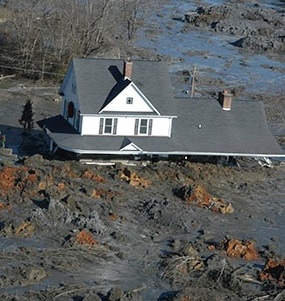Coal power plants are the biggest source of toxic water pollution in the U.S., mainly via coal combustion waste, which is the ash and sludge left over after burning the coal and filtering the exhaust (to keep the pollutants out of the air). Combustion waste contains heavy metals like lead and mercury that never degrade — they just “bioaccumulate” up the food chain until they reach us, doing untold damage along the way.
This week, a coalition of green groups released a report [PDF] about water pollution from coal plants, the extensive health and environmental costs it imposes, and the opportunity now before the EPA to finally do something about it. It’s worth reading the whole thing just to get a sense of the sheer scale of unregulated, unlimited water pollution that’s going on right now.
But I want to focus on one episode related in the report, something that should be prompting more outrage, not only from enviros but from anyone who cares about small-d democratic government. I demand more outrage!
First, a bit of background.
The standards that govern combustion waste from coal plants are 31 years old; EPA has said repeatedly that they are no longer sufficient to protect public health. And even those standards are barely enforced. Of the 386 coal plants these groups investigated, 70 percent “are allowed to dump unlimited amounts of arsenic, boron, cadmium, mercury, and selenium into public waters, in violation of the Clean Water Act.” Only 63 percent are required to even track how much they are dumping. And almost half the plants are operating with expired Clean Water Act permits.
This is a textbook case of pollution externalities: The coal plants are saving money by polluting public water and degrading public health. The public pays the health and environmental costs and the plant owners sell “cheap power.”
It’s a travesty. It’s also an opportunity for a public health win on par with removing lead from gasoline. (Ask Kevin Drum how that worked out.)
Earlier this year, EPA it sent its initial proposal to the White House with several options. Option 5, the strongest, would effectively eliminate coal plant water pollution, avoiding nearly 5.3 billion pounds of pollution a year. The next strongest, Option 4, would reduce pollution by 3.3 billion pounds a year.
Would these tough options crush the economy and strangle growth, as coal companies and Republicans inevitably squawk? No. From the green groups’ report:
Both of these options could be achieved without putting any significant burden on the coal industry. The EPA has calculated that Option 4 controls would remove pollution at a cost of about $70 per lb.; Option 5 would cost about $111 per lb. of pollution. These costs translate into far less than one percent of annual revenues for the vast majority of coal power plants and power companies …
Costs to ratepayers are equally small: the EPA estimates that Option 4 would, at most, add $3.89 to the average power bill per year — just over a penny per day to eliminate hundreds of thousands of pounds of toxic water pollution from our water. Option 5 would add $6.46 to the average annual bill—a bit less than two cents per day.
This is the conclusion of EPA’s scientific and technical experts: Each American could pay $6.46 a year — about the price of a day’s lunch — to virtually eliminate the nation’s largest source of toxic water pollution. Seems like a good idea.
Here’s where things get shady.
EPA sent the proposal over to the White House, where it was then reviewed, as almost all regulations are, by the Office of Management and Budget, an agency established ostensibly to coordinate actions across the executive branch.
OMB has also been tasked by presidents since Reagan (who created the office) with running cost-benefit analysis on agency regulations, a process of dubious constitutional provenance, as Lisa Heinzerling has explained. Many laws these regulations are meant to enforce do not call for cost-benefit analysis and some even explicitly prohibit it. The Clean Air Act and Clean Water Act in particular are designed to meet public health standards, not cost-benefit standards. Furthermore, the laws task EPA, which is accountable to the public through a detailed comment process, with developing standards — not OMB, which operates almost entirely in secrecy, with no outside review.
Anyway, the report’s authors, via FOIA request, got their hands on the “redline” copy of EPA’s proposal, showing how OMB changed it. Suffice to say, the darkest suspicions of OMB-haters were justified. OMB claims simply to be running cost-benefit analysis, making sure things pencil out, but this episode is a stark and damning example of just how hollow that pretense is. What OMB did to the combustion-waste rule is as unambiguous as it is infuriating: It watered down the rule to industry’s benefit. That’s it.
Here are some details:
OMB would not let the EPA select Option 4, the most protective of the EPA’s preferred options, and instead inserted new, weaker, options into the rule as “preferred.” Suddenly, the rule had four “preferred” options — three of them the products of the OMB process.
Needless to say, all three of the OMB’s options were radically weaker than all of EPA’s original preferred options:
While the weaker of the EPA’s original preferred options would eliminate 1.623 billion pounds of pollution annually, OMB’s Option 3a would control just about 460 million pounds of pollution per year, and Option 3b would control just 914 million pounds.
But it gets worse. This, to me, is just astonishing:
Having created new options that are contrary to the EPA’s view of what the best technology is, OMB went on to rewrite the EPA’s proposal, taking positions that are directly opposed to the expert opinions formerly expressed by EPA staff. For instance, the EPA had written, correctly, that “surface impoundments” — settling ponds — “do not represent the best available technology for controlling pollutants in [scrubber sludge]” in almost all circumstances. OMB deleted this sentence, and instead announced that “EPA” was proposing options that would keep using “surface impoundments for treatment of [scrubber sludge]” — exactly the opposite of what the EPA’s scientists had proposed.
OMB added other language endorsing ponds and parroting industry concerns about the biological treatment that the EPA had proposed in Option 4. OMB added paragraph after paragraph of rationales for why Option 4 was not preferred, inventing “concerns” that warranted dropping that protective option. None of this language was in the EPA’s original proposal.
This is maddning. I mean, tighter controls on coal combustion waste are as close to a cost-benefit slam dunk as regulations are ever likely to get — and if history is any guide, EPA and its critics alike are underestimating the benefits and overestimating the costs.
What’s happening here is not objective cost-benefit analysis. OMB met with industry groups several times during the review process. It is known to weaken far more rules than it strengthens. The language it inserted in the draft comes straight from industry, not from scientists.
What’s going on here is that industry is being given an opportunity to water down rules before they are implemented. That should piss you off.
Not just because EPA might blow a chance to remove billions of tons of pollution from America’s water and prevent thousands of illnesses and deaths. (The final combustion rule is expected, after yet more delays, later this year; EPA could still theoretically choose Option 4 or 5, though it looks less likely now, obviously.)
It should piss you off because concentrated wealth, corporate power, has found yet another choke point, yet another way to insert itself in the process of governance that protects its profits at the expense of public welfare. It’s bad enough that industry can shower legislators with money to shape laws. Now, via their friends at OMB, they’re being invited into the White House to meddle with the way laws are implemented.
Aren’t the interests of plutocrats pretty well represented in U.S. government already? How much is enough?



